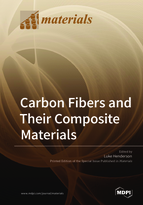Carbon Fibers and Their Composite Materials
A special issue of Materials (ISSN 1996-1944).
Deadline for manuscript submissions: closed (20 December 2018) | Viewed by 53288
Special Issue Editor
Interests: carbon fiber compsoites; surface modification; interface analysis; organic synthesis; ionic liquids
Special Issues, Collections and Topics in MDPI journals
Special Issue Information
Dear Colleagues,
Carbon fiber is synonymous with high performance. It is a key material in the reduction of CO2 emissions via light-weighting mass transport vehicles, often thought of as an alternative to traditional structural materials, such as metals. Despite being around for decades, carbon fibers themselves and their composites are still an extremely active area of research, spanning from fiber production through to their large-scale application in the aerospace industry. The study and characterization of the fibers, resins, fiber-matrix interactions, nano-fillers, and novel resins all contribute to a larger tapestry of understanding towards the factors defining the performance of composite materials.
This Special Issue will focus on recent work that focuses on advancing the performance of carbon fiber composites. Topics can include, but are not limited to:
- Fiber characterization using novel techniques
- Interface analysis and fiber-to-matrix adhesion
- Chemical Modifications of resins, sizings, or fibers and effect on performance
- Non-structural applications of carbon fiber
Assoc. Prof. Luke Henderson
Guest Editor
Manuscript Submission Information
Manuscripts should be submitted online at www.mdpi.com by registering and logging in to this website. Once you are registered, click here to go to the submission form. Manuscripts can be submitted until the deadline. All submissions that pass pre-check are peer-reviewed. Accepted papers will be published continuously in the journal (as soon as accepted) and will be listed together on the special issue website. Research articles, review articles as well as short communications are invited. For planned papers, a title and short abstract (about 100 words) can be sent to the Editorial Office for announcement on this website.
Submitted manuscripts should not have been published previously, nor be under consideration for publication elsewhere (except conference proceedings papers). All manuscripts are thoroughly refereed through a single-blind peer-review process. A guide for authors and other relevant information for submission of manuscripts is available on the Instructions for Authors page. Materials is an international peer-reviewed open access semimonthly journal published by MDPI.
Please visit the Instructions for Authors page before submitting a manuscript. The Article Processing Charge (APC) for publication in this open access journal is 2600 CHF (Swiss Francs). Submitted papers should be well formatted and use good English. Authors may use MDPI's English editing service prior to publication or during author revisions.
Keywords
- Carbon Fiber
- Composites
- Interfacial Adhesion
- Characterization
- Mechanical Properties
- Sizing and Surface Treatment
- Resins







